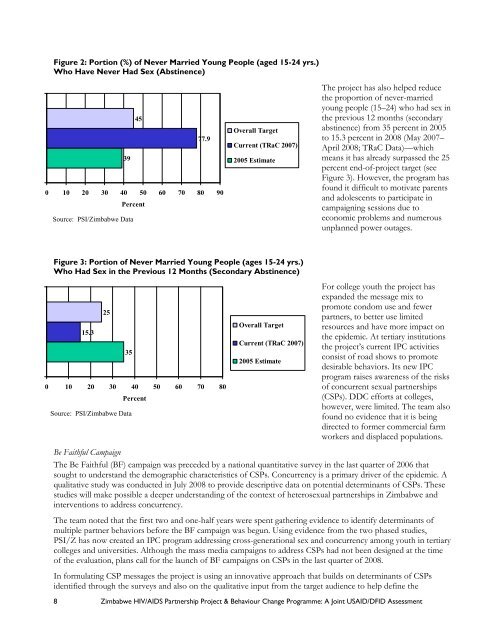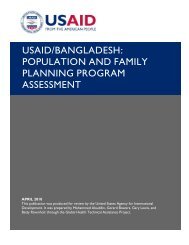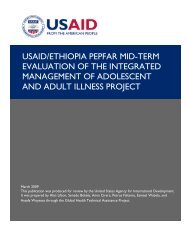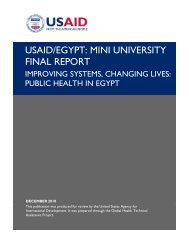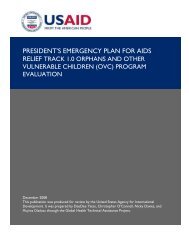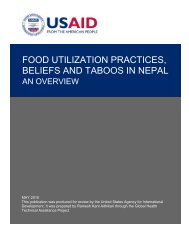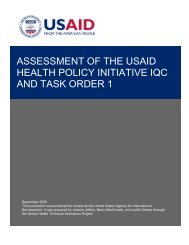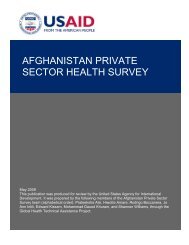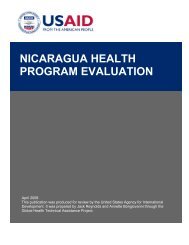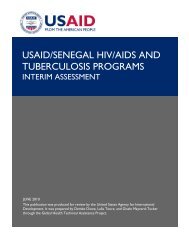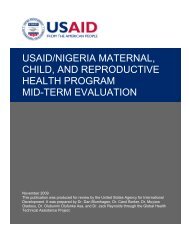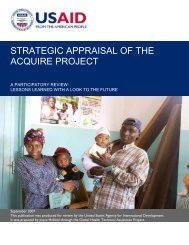3. EVALUATION FINDINGSPROGRESS TOWARD PLANNED RESULTSA broad-based approach to <strong>HIV</strong> prevention is clearly warranted. The interventions chosen by PSI/Z and the otherorganizations within the <strong>Partnership</strong> <strong>Project</strong> are sound. The wide reach of services offered through PSI/Z and thenumbers of individuals it is reaching are evidence that the interventions chosen are appropriate. Private sectorbasedactivities add to the options available through the public sector.CommunicationsThe <strong>Partnership</strong> <strong>Project</strong>’s communication activities have focused on behavior change, marketing, and servicecommunications. The project worked closely with major stakeholders in <strong>Zimbabwe</strong>, such as the National <strong>AIDS</strong>Council (NAC), MOHCW, United Nations Population Fund (UNFPA) and the <strong>Zimbabwe</strong> National FamilyPlanning Council (ZNFPC) in drafting the National <strong>Behaviour</strong> <strong>Change</strong> Strategy (2006–2010).Behavior <strong>Change</strong> Communication (BCC)The BCC strategy was based on a balanced portfolio with abstinence and being faithful as major themes. So far theBCC component has made significant progress in increasing adoption of safer sexual behaviors throughcommunications tailored to specific groups. The evidence-based BCC component was informed by a quantitativestudy 1 in the fourth quarter of the first year that was used to guide national mass media and interpersonalcommunications campaigns. BCC consists of three complementary campaigns: Delayed Debut, Be Faithful, andStigma and Discrimination. PSI also implements BCC through interpersonal communication (IPC) activitiespromoting condom efficacy and self-efficacy to negotiate condom use and use condoms correctly. This activity isimplemented in areas that have high population density, high <strong>HIV</strong> prevalence, and less media reach.Delayed Debut CampaignThrough mass media the DDC reached 415,000 young boys and girls in year 1 (2005/2006) with messages aboutdelaying their sexual debut. The mass media effort was supported by information, education, and communication(IEC) materials in the form of brochures, posters, and stickers distributed at popular meeting places for youth,such as movie houses, churches, schools, and public libraries. Safe from Harm (SFH), an IPC program thatpromotes parent-child communication to help address factors leading to early sexual activity among youths 13–19was also part of the DDC. SFH activities were conducted through faith-based organizations (FBOs) whose pastorswere given training. With their new skills, pastors were expected to communicate with young people and others intheir congregations. The SFH program operated in Harare, Matebeleland, Manicaland, Bulawayo, Bindura, andMarondera. All methods used in the campaign stressed creating positive role models for young men and women;broadening the view of youth about manhood and womanhood; and other issues that could motivate individuals todelay their first sexual activity.The DDC contributes to safer sexual behavior by helping youth to identify and deal with pressures to engage inearly sex. These and other efforts seem to be working. Recent information shows there has been an increase in thepercentage of never-married young people 15–24 who have never had sex from 39 percent in 2005 to 77.9 percentin 2008 (May 2007–April 2008; TRaC data). The end-of-project target for this statistic was 45 percent (see Figure2).1 <strong>Zimbabwe</strong> (2006): <strong>HIV</strong> Prevention TRaC Study among General Population (15-49 years); Second Round<strong>Zimbabwe</strong> <strong>HIV</strong>/<strong>AIDS</strong> <strong>Partnership</strong> <strong>Project</strong> & <strong>Behaviour</strong> <strong>Change</strong> Programme: A Joint USAID/DFID Assessment 7
Figure 2: Portion (%) of Never Married Young People (aged 15-24 yrs.)Who Have Never Had Sex (Abstinence)4577.9390 10 20 30 40 50 60 70 80 90PercentSource: PSI/<strong>Zimbabwe</strong> DataOverall TargetCurrent (TRaC 2007)2005 EstimateThe project has also helped reducethe proportion of never-marriedyoung people (15–24) who had sex inthe previous 12 months (secondaryabstinence) from 35 percent in 2005to 15.3 percent in 2008 (May 2007–April 2008; TRaC Data)—whichmeans it has already surpassed the 25percent end-of-project target (seeFigure 3). However, the program hasfound it difficult to motivate parentsand adolescents to participate incampaigning sessions due toeconomic problems and numerousunplanned power outages.Figure 3: Portion of Never Married Young People (ages 15-24 yrs.)Who Had Sex in the Previous 12 Months (Secondary Abstinence)15.325350 10 20 30 40 50 60 70 80PercentSource: PSI/<strong>Zimbabwe</strong> DataOverall TargetCurrent (TRaC 2007)2005 EstimateFor college youth the project hasexpanded the message mix topromote condom use and fewerpartners, to better use limitedresources and have more impact onthe epidemic. At tertiary institutionsthe project’s current IPC activitiesconsist of road shows to promotedesirable behaviors. Its new IPCprogram raises awareness of the risksof concurrent sexual partnerships(CSPs). DDC efforts at colleges,however, were limited. The team alsofound no evidence that it is beingdirected to former commercial farmworkers and displaced populations.Be Faithful CampaignThe Be Faithful (BF) campaign was preceded by a national quantitative survey in the last quarter of 2006 thatsought to understand the demographic characteristics of CSPs. Concurrency is a primary driver of the epidemic. Aqualitative study was conducted in July 2008 to provide descriptive data on potential determinants of CSPs. Thesestudies will make possible a deeper understanding of the context of heterosexual partnerships in <strong>Zimbabwe</strong> andinterventions to address concurrency.The team noted that the first two and one-half years were spent gathering evidence to identify determinants ofmultiple partner behaviors before the BF campaign was begun. Using evidence from the two phased studies,PSI/Z has now created an IPC program addressing cross-generational sex and concurrency among youth in tertiarycolleges and universities. Although the mass media campaigns to address CSPs had not been designed at the timeof the evaluation, plans call for the launch of BF campaigns on CSPs in the last quarter of 2008.In formulating CSP messages the project is using an innovative approach that builds on determinants of CSPsidentified through the surveys and also on the qualitative input from the target audience to help define the8 <strong>Zimbabwe</strong> <strong>HIV</strong>/<strong>AIDS</strong> <strong>Partnership</strong> <strong>Project</strong> & <strong>Behaviour</strong> <strong>Change</strong> Programme: A Joint USAID/DFID Assessment


